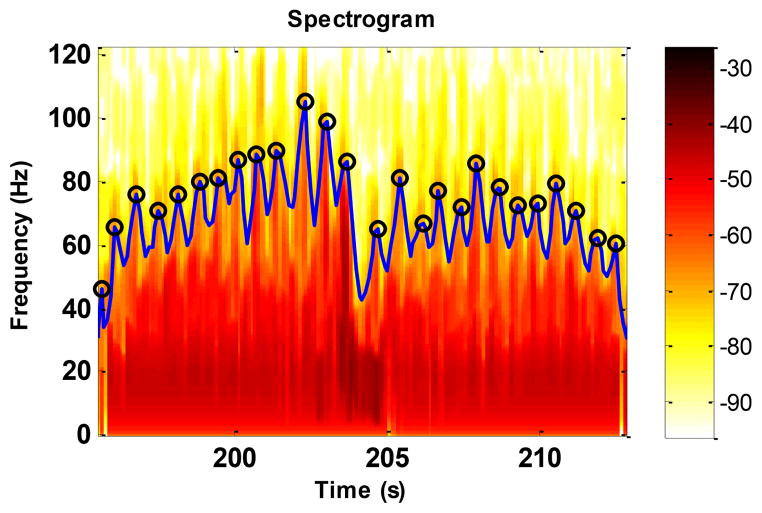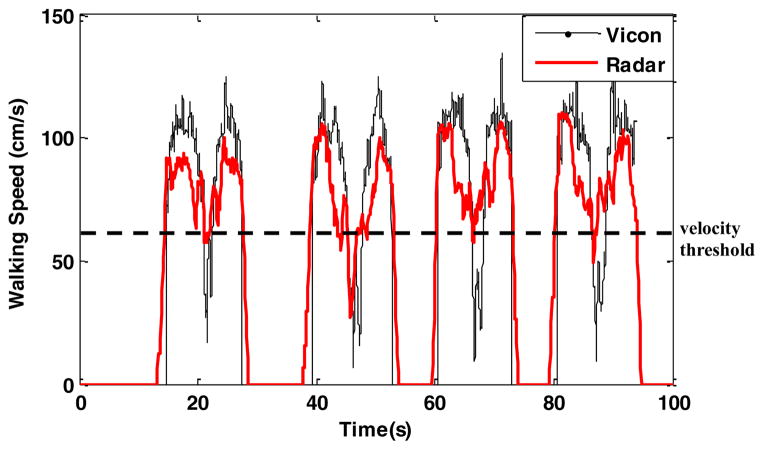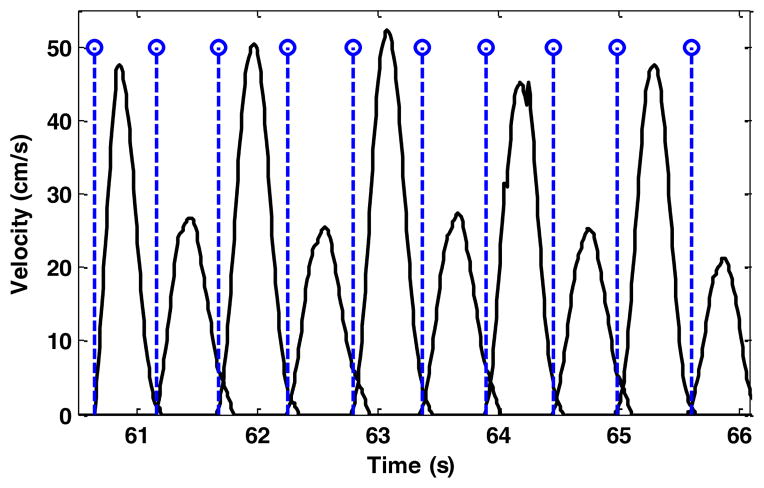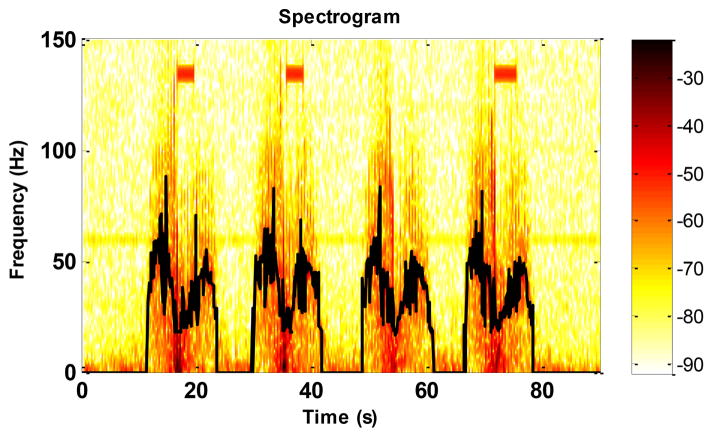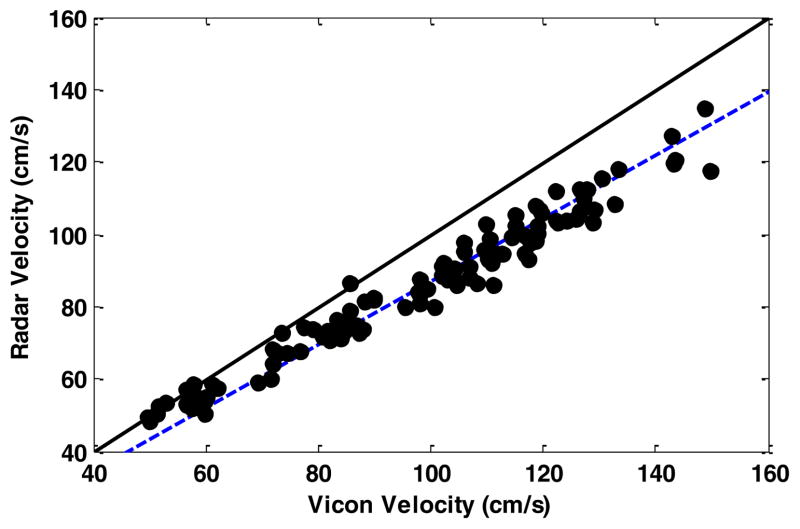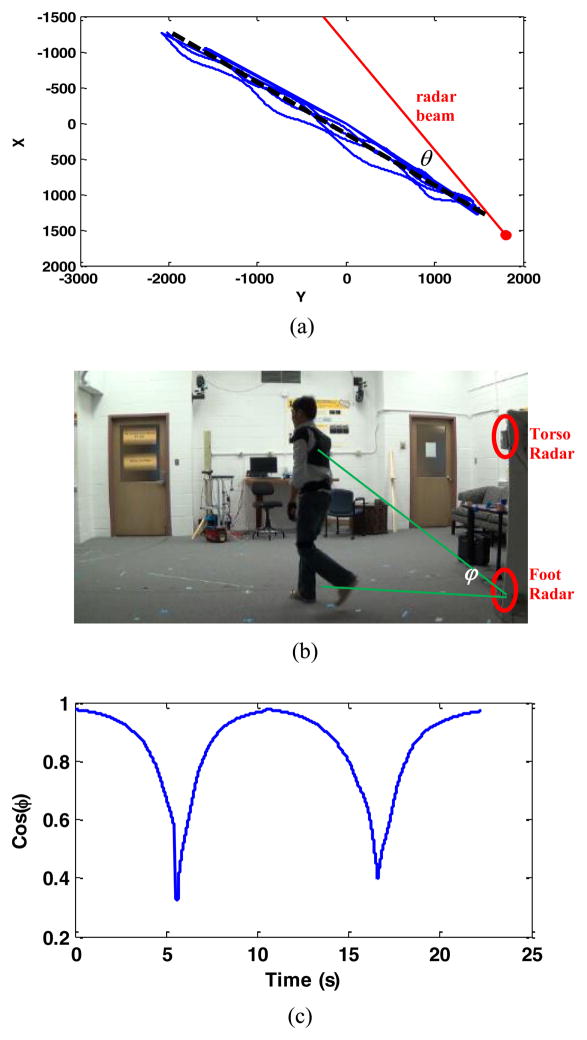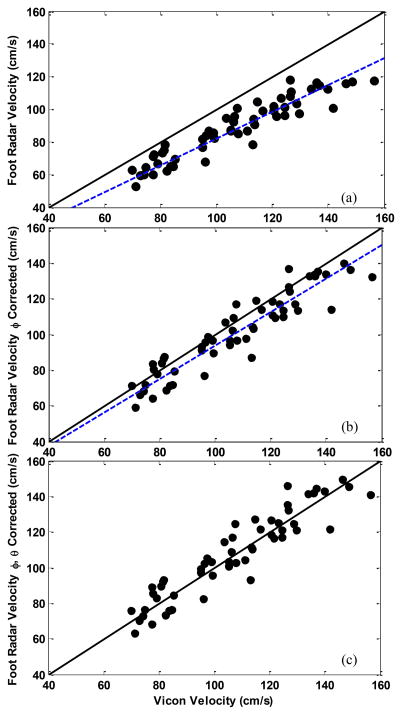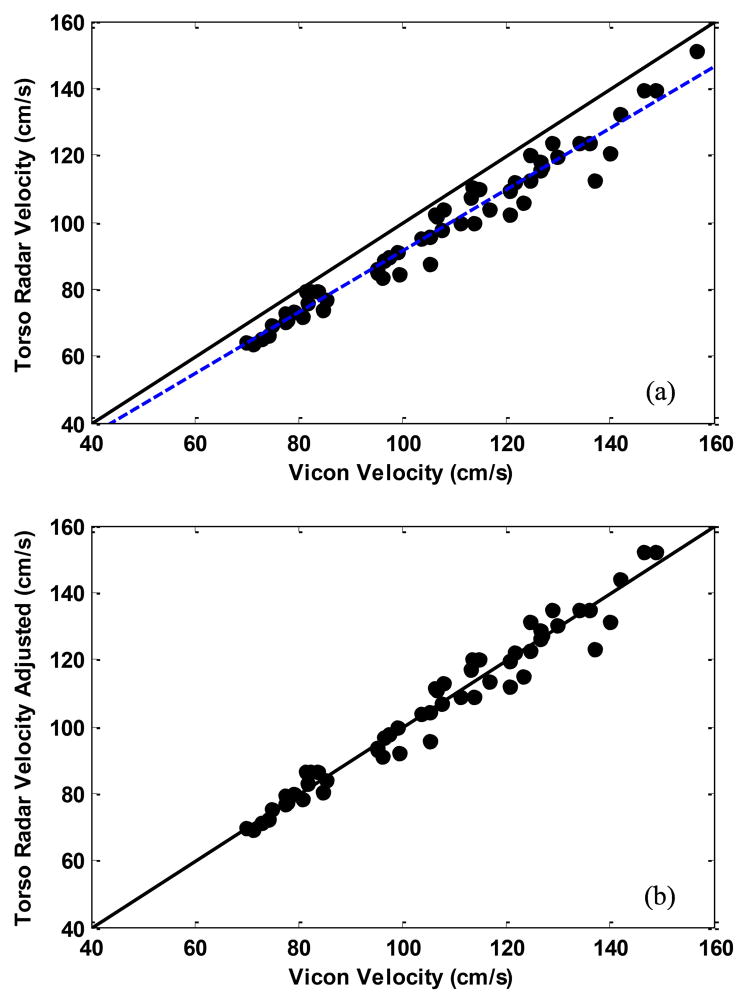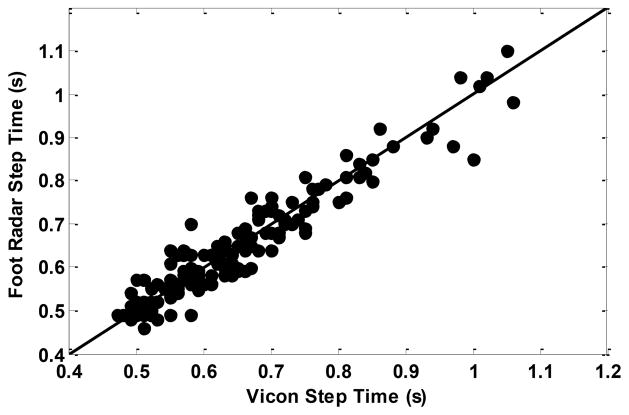Abstract
In this paper, we propose a pulse-Doppler radar system for in-home gait assessment of older adults. A methodology has been developed to extract gait parameters including walking speed and step time using Doppler radar. The gait parameters have been validated with a Vicon motion capture system in the lab with 13 participants and 158 test runs. The study revealed that for an optimal step recognition and walking speed estimation, a dual radar set up with one radar placed at foot level and the other at torso level is necessary. An excellent absolute agreement with intraclass correlation coefficients of 0.97 was found for step time estimation with the foot level radar. For walking speed, although both radars show excellent consistency they all have a system offset compared to the ground truth due to walking direction with respect to the radar beam. The torso level radar has a better performance (9% offset on average) in the speed estimation compared to the foot level radar (13%–18% offset). Quantitative analysis has been performed to compute the angles causing the systematic error. These lab results demonstrate the capability of the system to be used as a daily gait assessment tool in home environments, useful for fall risk assessment and other health care applications. The system is currently being tested in an unstructured home environment.
Index Terms: Eldercare technology, gait analysis, passive monitoring, radar, step time, walking speed
I. Introduction
Researchers have revealed great advantages of aging in place where seniors would be able to remain in the home environment of their choice with supportive health care services provided as needed [1]. However, there are huge challenges in keeping older adults healthy and functionally able so that they can age in place. One of the challenges of keeping seniors living independently is falls. Falls are a major cause of morbidity in elders; one out of three adults age 65 and older falls each year [2]; falls are the leading cause of injury death among older adults 65 or older [3]; the direct medical costs of falls, adjusted for inflation, was $30.0 billion in 2010 [4].
Increased fall risk in the elderly has been associated with changes in gait characteristics including gait speed decline, stride frequency increase, and stride length decrease at a given walking speed [5]. We are developing an in-home fall risk assessment system that incorporates different low-cost passive sensors for early detection of gait changes in order to screen which elderly people are more at risk of falling. We aim to detect gait changes over time early enough so that effective strategies can be implemented to prevent or reduce severe negative health outcomes, and evaluate healing/deterioration following an intervention. The goal is to enable elderly people to maintain quality of life in their own home with adequate health care while preventing or reducing institutional care. We believe the key to both better health and lower healthcare cost is prevention, which hinges on early detection and early intervention addressing risk of falls.
Unobtrusive continuous quantitative activity and gait assessment and monitoring offer great advantages for the early detection of health changes including real-time detection of changes in fall risk, as well as monitoring elderly activity and gait analysis in a home environment remotely while preserving privacy [6], [7]. The major advantages of the pulse-Doppler radar with respect to other technologies are that it makes unobtrusive characterization of human gait possible by using the Doppler effect of electromagnetic waves and is much less affected by environmental conditions such as lighting and furniture clutter.
In the next section, we discuss related work in this field. Section III gives a detailed description of the gait analysis methodology. Section IV presents validation experiments and results. We offer discussion in Section V, and conclude in Section VI.
II. Related Work
In health care, detailed gait analysis necessary for fall risk assessment is commonly done by health care providers directly assessing gait or by trained personnel using a gait lab. Typically, assessment of walking ability may or may not be a part of a routine primary care office visit for an older person and it is difficult for the health care provider to compare accurately from one visit to another. Assessments performed in a gait lab are accurate but costly, and typically performed too infrequently to detect changes in time for interventions to be successful. In addition, our research has revealed that people display different gait patterns when they are tested in a lab setting as compared to in a home environment [6], [8]. There is a clear need for a low cost, continuous gait assessment tool for older adults that can be deployed in a home environment to capture the whole picture of an elderly person’s gait and detect changes so that treatment to improve walking ability can be initiated in time to reduce the risk of debilitating, costly falls.
With advancements in technology, researchers have attempted to deploy different techniques for continuous gait assessment with varying degrees of obtrusiveness. Among the most studied techniques are those using wearable accelerometers and gyroscopes. Many wearable systems have demonstrated accuracy and precision, but suffer from limitations such as short battery life, the need to download the data or introduce additional hardware for wireless data collection, and the inconvenience of both having to wear the device and having to remember to consistently wear it. Research shows compliance with consistently wearing the device declines over time [9]. For these reasons, wearable devices are currently inadequate for a long-term, in-home, unobtrusive monitoring.
Low-cost passive sensor systems for gait assessment, such as inexpensive passive infrared motion sensors, are used for continuous and unobtrusive assessment of mobility and walking speed in the home [10]. However, such systems can provide only walking speed as the single gait parameter. While walking speed is a good and important gait parameter, additional parameters are needed for a more complete fall risk assessment [11].
Vision sensors are a rich source of information that can be used for gait analysis; vision-based gait analysis has been an active research topic in the computer vision community. Our low-cost multiwebcam system [6] has been shown to provide accurate unobtrusive gait assessment in a noncontrolled multi-person home environment. Despite the advantages, it also faces challenges of lighting condition, occlusion, and computation complexity.
There are a number of existing studies using radars, including Doppler radar, and ultrawideband pulse radars, in medical monitoring applications, such as respiration and heartbeat vital sign monitoring [12], [13]. Recent research also explored the concept of using these radars for gait analysis. Geisheimer et al. [14] demonstrate that different human body parts generate different radar signatures. Tahmoush and Silvious [15] use Ku-band and Ka-band radar in an outdoor environment to estimate the gait velocity from the frequencies with the highest reflection levels, and then extract stride rate from the velocity. Otero [16] uses a continuous wave radar to detect and classify people based on the Doppler signatures (velocity and stride rate) they produce when walking. The stride rate is estimated by taking the Fourier transform at each Doppler frequency bin after computing the radar spectrogram. Tivive et al. [17] proposed a method of characterizing the human motion based on the nature of arm swings using Doppler radar. Orović et al. [18] introduced a human gait classification method based on the time–frequency analysis of the radar data, and the motion signature obtained from the arm and leg movements. Kim and Ling [19] investigated the feasibility of classifying different human activities using micro-Doppler signature.
With the advance of digital techniques, pulse-Doppler radars have become light and inexpensive, and Doppler processors for coherent pulse radars are more common. The advantage of combining Doppler processing with pulse radars is to provide accurate velocity information. This velocity is called range-rate. It describes the rate that a target moves toward or away from the radar. Pulse Doppler radar has the advantage of low power consumption, simple radar architecture, and accurate velocity estimation. These features are important for long term, passive, remote in-door gait monitoring. We have developed our sensor system based on the Doppler radar from GE security design [20] and implemented several modifications for increased sensitivity for the medical application. Advanced signal processing techniques are developed and utilized to reliably extract the gait parameters.
There are a number of existing studies that employ a radar system and investigated walking velocity and stride rate estimation using radar qualitatively [21]–[24]. However, none have developed an automated approach and system for on-going gait analysis for assessment of fall risk, and no large dataset was studied statistically and validated quantitatively. Therefore, in contrast to the existing published research, we employed a different radar system (pulse-Doppler radar), developed algorithms for gait analysis and conducted large-scale experiments with highly accurate ground truth to evaluate the accuracy and reliability of the radar system.
III. Gait Analysis Methodology
A. Radar and Human Motion
A human body is an articulated object, comprising a number of rigid parts connected by joints. The walking gait is a complex motion of swinging arms and legs. Obtained from webcam images, Fig. 1(a) illustrates this through various poses of a human walking.
Fig. 1.
(a) Human walk illustration and (b) associated Doppler radar spectrogram (blue line: torso motion, black circle: leg swing).
The radar transmits an electromagnetic wave at a specific frequency and measures the shifts in the reflected waves. These frequency shifts can then be used to obtain the velocities of the person’s body parts in the radar’s direction. Different body parts create distinct Doppler signatures when a person moves, which can be easily viewed through a spectrogram. The spectrogram is the short-time Fourier transform of the radar signal, defined as:
| (1) |
where t is time, f is frequency, r is the radar signal, and w is a sliding window function.
A spectrogram showing a typical Doppler signature of a person walking is shown in Fig. 1(b), where the horizontal axis represents time t, the vertical axis represents frequency f and the color at any point represents the energy of the signal at a certain time and frequency P (f, t). The energy is color coded with red being the highest intensity and white the lowest. These plots are obtained by taking a succession of FFTs, each over a short-time window. The integration time used in our study is 0.4 s and consecutive FFT windows have 50% overlap. Fig. 1(b), thus, shows how the spectra of the reflected signals change as a function of time during a human walk in the direction of the radar beam.
The frequency shift with the highest reflected energy yields the torso motion speed as the torso has the largest surface area in a human body, thus the gait velocity. Leg swings generate a much higher frequency shift due to the motion being faster than that of the torso. However, the reflected energy from the legs is lower due to their smaller radar cross-section area. Nevertheless, the reflections from the legs are still visible in the radar spectrogram and this information can be used to extract stride duration information. Signal processing algorithms are designed and implemented to extract human movement parameters that are employed by these strategies. During the act of walking the human body structure moves cyclically from the swing phase where there is forward motion of the legs [“o” in Fig. 1(b)], to the double support phase when both feet are on the ground and the most body parts are moving at the overall velocity of the walker, which corresponds to a peak torso velocity. This cyclic pattern is clearly visible in the spectrogram shown in Fig. 1(b).
B. Walk Segmentation for Gait Analysis
When presented with a large amount of radar data of a person’s daily activities, it is necessary to locate the walk segment suitable for gait analysis. Unlike critical monitoring such as fall detection and vital sign monitoring, the problem of locating suitable walking segments can be overcome in our application, as long as some good walking sequences can be identified. When this technology is deployed in a home, identifying a few good gait sequences each day is sufficient to serve the gait monitoring purpose. When presented with the input radar data, the walking speed is first estimated based on Section III-C, and then the walking segments are selected with Algorithm I. The step time estimation described in Section III-D can be done in the selected walk segment. The speed threshold in Algorithm I is set to be 40 cm/s in the study, and can be varied based on the subject’s normal walking speed. The walking sequence length threshold is set to Tt = 3 s.
Algorithm I.
walking sequences selection
| For each input data point |
| If (speed > threshold) |
| If (continuous) |
| Add to the current existing walk sequence |
| Else |
| Start a new sequence |
| Keep the previous sequence if the length is greater than Tt second |
C. Walking Speed
Doppler radars use the principle of the Doppler effects to measure the velocity of a target. Doppler theory states that an electromagnetic wave reflected from a moving target undergoes a frequency shift proportional to the velocity of the target. This enables the estimation of different movement parameters such as torso velocity and step time [22], [24].
The equation for computing the nonrelativistic Doppler frequency shift, Fd, of a simple point scatter moving with speed v with respect to a stationary transmitter is:
| (2) |
where Ft is the frequency of the transmitted signal, θ is the angle between the subject motion and the beam of the radar in the ground plane, φ is the elevation angle between the subject and the radar beam, and c is the speed of light. For complex objects, such as walking humans, the velocity of each body part varies over time. Additionally, the radar cross-section of various body parts is a function of aspect angles. Walking speed is estimated by the torso velocity, vtorso, which corresponds to the frequency shift with the highest reflected energy, and is extracted using Algorithm II.
Algorithm II.
walking speed estimation:
|
D. Step Recognition
As mentioned earlier, a leg swing generates a much higher frequency shift than the torso motion, but the reflected energy is lower due to their smaller radar cross-section area. Therefore, in order to extract the leg swing instance, background noise subtraction is necessary.
The noisy spectrogram pixel estimate, P (t, f), at frequency index f and time t, consists of background noise Pback (t, f) and the actual signal due to motion Pm (t, f) as P (t, f) = Pm (t, f) + Pback (t, f). Thus, the estimated value of the background noise can be subtracted from each computed pixel P (t, f) in order to obtain Pm (t, f). The value of the background signal at each frequency Pback (f) can be used instead of Pback (t, f) and can be estimated by averaging Pback (t, f) over the time t. Thus, the power of the Doppler signal due to motion only, Pm (t, f), can be estimated as:
| (3) |
Algorithm III.
step recognition:
|
The step recognition is performed as Algorithm III. A preselected energy threshold Pth is set to be −70 dB, and the constant c in the peak selection step is chosen as 0.01 in the study. The last step in Algorithm III is used to eliminate the step instances that may come from the signal fluctuation and are picked up by the peak detection. The value 0.35 s was selected in determining the step instances that are too close, which is based on the findings of this study as well as our previous work [6] that the step time is normally greater than 0.4 s including healthy young adults. An example spectrogram with extracted step instances is shown in Fig. 3. The step time T is then computed from the time intervals between step instances.
Fig. 3.
Spectrogram after background noise subtraction with time-domain signal F(t) in blue line and extracted steps (o).
E. Vicon as Ground Truth
The commercial 3-D motion analysis system, Vicon MX, allows for very accurate measurement of movement, using reflective markers and seven simultaneous cameras. The cameras emit infrared light signals and detect the reflection from the markers attached to the participant’s head and the toe of both shoes. Based on the angle and time delay between the original and reflected signals, it tracks the movement trajectories of the reflective markers in 3-D space. The Vicon cameras were sampled at 100 Hz and were properly calibrated according to the manufacturer’s instructions prior to data collections.
Walking speed can be easily computed using the torso marker 3-D location information. A comparison of walking speed obtained from Vicon versus radar is illustrated in Fig. 4. The radar and Vicon were synchronized using time stamp, and the velocity was used as a feature for visual inspection of the alignment.
Fig. 4.
Walking speed comparison: Vicon versus radar. Dashed line: velocity threshold selected.
A footfall is a momentarily stationary location of the foot. The accurate detection of the footfall is achieved by monitoring the foot markers’ velocity M(t) at time t. As shown in Fig. 5, the footfalls are identified as the markers’ cross zero velocity from stationary to motion. Once the footfalls are identified, the step time is extracted from the time information associated with each footfall. As mentioned earlier, radar system relies on the detection of leg swing motion for step recognition, then computes the associated gait parameters. In the time domain, each step time segment based on the initial foot motion used by the Vicon is likely not to align exactly with the one based on the peak motion estimated by the radar. These two motions happen at two different times. However, this exact alignment of the two in step recognition is not critical as we are interested only in the time intervals between step instances as the step time. The low-cost radar system is able to accurately estimate these gait parameters compared to the ground truth.
Fig. 5.
Foot velocity obtained from Vicon markers attached to the shoes (black lines), and steps recognized (blue dash line).
IV. Experimental Results
A. Study Overview
The purpose of this study is to evaluate the pulse-Doppler radar’s accuracy and reliability in assessing human gait in an indoor environment, and to investigate the feasibility of developing and eventually deploying such technology for continuous eldercare gait assessment in the home.
Thirteen volunteers (seven females, six males, age 23–67) were recruited to participate in the study, with Doppler radar, Vicon and other sensors including web cameras, Microsoft Kinect depth camera recording. All participants provided informed consent. The participants with Vicon reflective markers attached to the toe of both shoes and their back were asked to walk in their normal speed, slow speed, and faster speed for a 17 ft distance, straightly toward the radar, turn around, and return to the starting point. The walking segment can be clearly observed on the spectrogram in Fig. 2 where the person starts to accelerate from a fixed stance toward the radar, reaches an approximately constant velocity, then begins to slow down, turns around, and begins to walk in the opposite direction.
Fig. 2.
Extracted frequency shift from torso motion (black line) shown in a spectrogram.
The experiments were conducted in two sessions with different radar arrangements: 1)single radar setting: one radar was placed on the ground, 2) dual radar setting: one radar was on the ground, and the second radar was 1.25 m directly above the ground. They are referred as foot radar and torso radar respectively in this paper. The foot radar on the ground level is expected to produce a more accurate foot step estimation; and the torso radar is at the same height of a person’s torso for a more accurate estimation of the torso’s velocity. All radars were placed directly at the end of the walkway. Vicon markers were attached on both radars in the dual radar setting (not the single radar setting) to obtain the radars’ 3-D locations for further analysis.
Each continuous straight walk period is considered as a walking segment. In total, there are 168 walk segments collected, with 112 walk segments collected from eight participants with the single radar setting, and 56 walk segments collected from five participants with the dual radar setting. Half of the walk segments are in the “toward” radar direction, and the other half are in the “away” from radar direction. The numbers of “slow,” “normal,” and “fast” speed walks are the same in either direction for each participant.
The radar used in the experiments is an off the shelf pulse-Doppler range control radar, RCR-50 from GE Security [20], which has a carrier frequency of 5.8 GHz, a pulse repetition frequency of 10 MHz, a duty cycle of 40%, and a variable range setting of 20 to 50 ft. The radar was designed as a security device to detect any motion in a room. To fit the gait assessment application, the range was set to 20 ft, and the integrated infrared sensor is disabled. The radar’s back was covered by a 2 ft × 2 ft metal shield to reduce interference. The RCR mixes the transmitted and reflected signals and passes the resulting waveform through a low-pass filter to capture the frequency shift. The collection of the radar signal is done using a data acquisition (DATAQ) unit [25]. The radar outputs this low-pass filtered signal, which is then digitalized and sampled at 960 Hz and stored.
Prior to the data collection, the radar system was calibrated with the following two steps: 1) online calibration: the real-time signal waveform is observed through DATAQ software directly. The radar position, direction and shield are adjusted until the waveform is accurate and clear enough to reflect the testing motion in the radar range. 2) offline calibration: some sample data of sequences are collected of a person walking toward or away from radar. The radar position, direction, and shield are again adjusted until the spectrogram of the walk pattern is clear enough to differentiate the step instances.
B. Results
The gait parameters obtained from the tests cover a large variation: velocity ranges from around 50 to 150 cm/s, step time from around 0.5 to 1.1 s. The set of experiments was designed to test the radar system with some extreme walking patterns as demonstrated by the large variation in the gait parameters. For the application of elderly in-home gait assessment and monitoring, the variations of the walking speed and step times are expected to be much less.
1) Velocity Estimation
As illustrated in Fig. 4, velocity obtained from the Vicon was used as ground truth for comparison. Walk sequences were obtained using Algorithm I, and the threshold value of 50% of the peak speed was used. Only speed results above the threshold were used for comparison. This method has been tested before in a realistic living environment to segment the continuous walk [6].
The velocity comparison results for the single radar setting are shown in Fig. 6. Clearly, the walking speed obtained from the radar system is consistently lower than the ground truth values. The relation between the radar estimated speed and the Vicon ground truth is approximated as: vradar = 0.87*vvicon. This observation is mainly due to the fact that the radar can only detect the effective velocity directly toward or away from the radar as ve3 = (vrealcosθcosφ), and it also matched results in Fig. 4, where radar speed results above the threshold used for comparison are consistently lower than the Vicon ones. Furthermore, it is also interesting to observe that, for many areas below the threshold velocity, which are not used for comparison, the radar instead overestimates the velocity. Using the Fig. 4 data segment from 10 to 30 s as an example, at around 10 and 30 s, the subject is at the farthest place from the radar, near the edge of the Vicon viewing area. It is believed that the discrepancy of the two systems here is mainly from the subject entering/exiting the Vicon viewing area, which caused the abrupt Vicon marker location change and consequential inaccurate Vicon velocity results. At around 20 s, near the middle of this data segment, the subject is at the closest distance to the radar with highest energy reflected as seen in the spectrogram, makes the turn around motion, and walks in the opposite direction. We believe the radar results may be affected by the turn around motion, and therefore are higher than the Vicon’s velocity.
Fig. 6.
Walking speed comparison for the single radar setting: Vicon versus Foot radar. Blue dashed line: vradar = 0.87* vvicon.
To further analyze the effects of angles θ and φ on the accuracy of the walking speed estimation, Vicon markers were attached to the radars in the dual radar setting to obtain the radars’ accurate 3-D positions. θ, the angle between the subject’s walking trajectory and the beam of the radar in the ground plane, was computed from the walking path fitting line and the radar’s pointing direction as a time invariant parameter for a particular walk segment, as shown in Fig. 7(a). Elevation angle φ is a time variant parameter [see Fig. 7(c)] that was estimated using the subject’s torso height and the distance to the radar in the ground plan as illustrated in Fig. 7(b).
Fig. 7.
Angle θ and φ affect the walking speed estimated by the radar: (a) θ estimation: walk paths (dash line: fitting line) and radar beam projected on the ground plane (red), (b) φ estimation and experiment setup, and (c) cosφ as a time variant parameter.
The velocity estimated from the floor radar and the torso radar is compared with the Vicon ground truth in Figs. 8 and 9, respectively, and are approximated as:
| (4a) |
| (4b) |
Fig. 8.
Foot radar walking speed comparison in the dual radar setting: (a) Vicon versus Floor radar. Dashed line: vfoot_radar = 0.82* vvicon. (b) Vicon versus Foot radar with angle φ corrected. (c) Vicon versus Foot radar with both angles φ and θ corrected.
Fig. 9.
Torso radar walking speed comparison in the dual radar setting: (a) Vicon versus Torso radar. Dashed line: vtorso_radar = 0.91* vvicon. (b) Vicon versus Torso radar with angle θ corrected.
It has been observed that the foot radar has a larger error than the torso radar in the velocity estimation when compared to the ground truth. This is because both θ and φ are nonnegligible for the foot radar, especially for φ when the participants are close to the radar. For the torso radar, on the other hand, φ is greatly reduced to a negligible level as the radar beam is at the similar height as the torso. In Figs. 8(a), (b), and (c), the foot radar estimated walking speed is corrected with computed angle φ first, and then angle θ. As expected, after angle φ correction, the foot radar results [see Fig. 8(b)] appear to be very similar the torso radar results [see Fig. 9(a)]. Since cosθ is, on average, 0.91 based on (4b), cosφ for the foot radar can be approximated as, on average, 0.82/0.91 = 0.90. Therefore, for the foot radar, the velocity errors caused by angle θ and φ are about the same level. It is worth mentioning due to the different radar placement and different participants in the two sessions, it is not surprising to see the foot radar in the dual radar setting produced a slightly different error on average than the foot radar in the single radar setting with respect to the ground truth.
Similarly, the torso radar walking speed was corrected with computed angle θ in Fig. 9. Compared to the foot radar, the torso radar data points are of a much tighter distribution, demonstrating a more accurate velocity estimation.
Table I lists the comparison between the Doppler radar and Vicon. Intraclass coefficients (ICCs) of the type (2,1) were used to evaluate the level of agreement between the radar and Vicon. The intraclass correlation coefficient (ICC) is a measure of the reliability of measurements which includes consistency and absolute agreement measures. Paired t-tests were used to determine the systematic difference between the two systems. Table I results revealed that both foot and torso radar have a good consistency (ICC consistency of 0.97 and 0.99, respectively) in measuring the subjects’ walking speed, but in terms of the absolute agreement, the torso radar has a much better performance of 0.96 than the foot radar of 0.87. This matched with the observance in Figs. 8 and 9. The paired T-test (p < 0.05) confirmed that the difference is statistically significant for both foot and torso radar. Thus, even though the radar measurement is consistent when compared to the Vicon ground truth, there is a systematic difference between the two measurements. The instructions to the participants were to walk straight toward the radar, but there were no constraints on the participant’s walking path, similar to an elderly person walking in a natural home environment. This is a major challenge in walking speed estimation using the radar in a home environment.
TABLE I.
Radar and Vicon In-Lab Comparison
| Radar | Vicon | ICC | ||
|---|---|---|---|---|
| Mean(S.D.) | Consistency | Absolute | ||
| Velocity1 (cm/s) | 86.0(19.6) | 100.4(25.3) | 0.97 | 0.87 |
| Step time1 (s) | 0.64(0.13) | 0.64(0.13) | 0.97 | 0.97 |
|
| ||||
| Velocity2 (cm/s) | 98.7(22.8) | 107.8(24.0) | 0.99 | 0.96 |
| Step time2 (s) | 0.66(0.13) | 0.61(0.09) | 0.16 | 0.15 |
ICC: Intra-class coefficient;
Velocity1 and Step time1: from the foot radar in both single and dual radar settings;
Velocity2 and Step time2: from the torso radar in the dual radar settings
2) Step Recognition
An excellent agreement in step time between the foot radar system and Vicon is achieved as shown in Fig. 10, where both the single radar and dual radar setting results are combined. A paired T-test showed that the differences between the two measurement systems under comparison are not statistically significant (p > 0.05). ICC of 0.97 demonstrates an excellent level of consistency and absolute agreement between the two systems under comparison. On the contrary, due to the height of the torso radar to the feet/legs, data analysis showed that the leg swing signals are too weak to produce decent step recognition.
Fig. 10.
Step time comparison: Vicon versus Foot radar including both single radar and dual radar setting.
It is clear that the foot radar system has a strong advantage in the step time estimation considering its accuracy and that it is unaffected by the environment, such as lighting variations, clothing, and occlusion due to clutter. It has great potential to be a complementary system to the vision sensors we have developed [6]. The vision sensors have the advantage of good performance in estimating unconstrained walking speed, but the step recognition is at times compromised by occlusion in a real living environment.
V. Discussion
The proposed Doppler radar in-home gait assessment system has been validated with Vicon ground truth. Results show that a dual radar setting is needed for an optimal walking speed and step time measurement and provides a clear advantage over the single radar system. The foot radar accurately estimates the step time compared with the ground truth with intraclass correlation coefficients of 0.97 in terms of consistency and absolute agreement. The walking speed estimation with both torso and foot radars is systematically lower than the ground truth due to the angles between the walking person and radar beam. Torso radar has clearly a higher accurate walking speed (on average 9% lower) than the foot radar (on average 13%–18% lower) because of the minimized elevation angle. We are in the process of testing the radar system in ten senior apartments with 13 resident participants for two years. The initial walking speed results collected with the single foot radar setting [24] are on average 14.5% lower before angle calibration and 10.5% lower after angle correction compared to the ones recorded by clinicians, in agreement with the lab results reported here. We will report further results as the study proceeds. We have found that in order to accurately estimate the walking speed, it is necessary to minimize the angle to the radar beam. This can be achieved through radar placement at the torso level, a constrained walking path in line with the radar beam, using only the walking segment in a certain distance, and using other sensors, such as vision sensors, for angle correction.
Through the study we have learned the radar system’s capability, strength, and drawbacks. Radar has clear advantages in the following aspects.
Operating conditions. The Doppler radar can operate in low or no light conditions, and is much less affected by clutter in the daily living environment.
Doppler-based devices are relatively insensitive to constant background effects, as these can usually be eliminated through background subtraction.
Computation cost and associated hardware cost. One advantage of the radar system lies in its cost, and its minimal energy consumption. Consequently they can be deployed in a long-term in-home monitoring or a remote diagnostic application. The entire Doppler radar system used for this study includes a $50 RCR-50 radar and a $500 wireless DATAQ unit. In addition, the radar signal processing is much less computationally intensive compared to, for example, color vision sensors.
Privacy. The radar system does not raise privacy concerns for in-home use.
Inevitably, the radar system also has some drawbacks. The approach of using Doppler radar to measure walking speed can be effective and accurate in the front direction, but its accuracy decreases with the increase of the angles between the radar beam and the walking direction, and eventually loses accuracy completely with the sagittal direction movement. In addition, Doppler-based mechanisms are affected by secondary moving objects in the range of the sensor, such as another moving person in the field of view of the radar, which cannot be easily identified and isolated.
To address these drawbacks, strategic placement of the radar system, such as at the end of a hall way, can help to optimize the system’s performance by constraining the walking direction to align with the radar beam. It may also prove useful to add a calibration step during which data from a specific home are used to generate a linear or low-order regression curve which minimizes the error between speeds measured by the radar and ground truth.
For our application, we are most interested in the changes in gait patterns as a means of detecting early health problems or functional decline. So a systematic offset in the walking speed as seen in this study is not necessarily a problem for detecting a pattern change. In addition, the incorporation of radar and other sensing techniques, such as vision sensors, would provide an improved overall system with proper sensor fusion. For example, the multiple vision sensor-based 3-D gait assessment system [8] developed has advantages in accurately capturing walking speed without walking direction constraints, but in many cases has difficulties in step recognition due to occlusion of the foot area by furniture and other objects in the home. The camera system faces challenges of variable lighting conditions, which is the strength of radar system. With the help of vision sensors, it is possible to remove secondary moving objects by tracking and segmenting out the target walker with the use of a suitable algorithm [26], and estimate the angles between the walker and the radar beam. Additionally, the low-power consumption and low computational complex radar could be used to provide triggering information for the vision sensors. This type of fusion holds great promise of being able to perform 3-D gait assessment in various environments at home.
Long-term in-home monitoring is expected to be more challenging than the lab setting monitoring demonstrated in this study, due to the complexity of the real-world environment. The work reported here is a first step toward investigating the feasibility of using such a system in an unstructured home setting. Although the positive results demonstrated the feasibility of deploying such systems in an elderly resident’s home, there are issues to be addressed in our future research.
We believe that the Doppler radar-based gait assessment is a promising avenue for future exploration. In particular, we hypothesize that Doppler-based gait recognition might be used synergistically with vision-based gait assessment systems since the two are complimentary in their capabilities and drawbacks.
There is still much potential to improve the performance of the Doppler radar system beyond that demonstrated in this paper. We will report the longitudinal study results of deploying the system in ten senior apartments currently as the study proceeds. All of these are our future research topics.
VI. Conclusion
In this study, we have proposed and validated a low-cost Doppler radar system for passive and continuous in-home gait assessment. Using signal processing techniques we explicitly estimated human torso velocity and leg swing for step recognition. We found the radar system has achieved a high accuracy on the step time estimation, while the walking speed estimation is systematically affected by the walking path direction.
The system is robust to environmental conditions, computationally efficient, and with no privacy concerns. Thus, this technology is especially suitable for passive, long-term use in an unstructured daily living environment.
Acknowledgments
This work was supported in part by the Agency for Health-care Research and Quality under Grant R01HS018477 and in part by the U.S. National Science Foundation under Grant CNS-0931607.
The authors acknowledge the contribution and support of the University of Missouri Eldertech research team.
Biographies
 Fang Wang (M’01) received the B.S. degree from Nankai University, Tianjin, China, in 1997, the M.S. degree from Southern Methodist University, Dallas, TX, USA, in 2000, and the Ph.D. degree in electrical and computer engineering from the University of Missouri, Columbia, MO, USA, in 2011.
Fang Wang (M’01) received the B.S. degree from Nankai University, Tianjin, China, in 1997, the M.S. degree from Southern Methodist University, Dallas, TX, USA, in 2000, and the Ph.D. degree in electrical and computer engineering from the University of Missouri, Columbia, MO, USA, in 2011.
From 2001 to 2006, she was with Motorola, Inc./Freescale Semiconductor, Tempe, AZ, USA, where she was engaged in the characterization and modeling for CMOS and BiCMOS technology development for RF/IF applications. From 2012 to 2013, she was a Senior R&D Engineer at Ansys Inc., Pittsburgh, PA, USA, working on EDA software development. She is currently an Assistant Teaching Professor in the Computer Science Department at the University of Missouri. Her research interests include computational intelligence, pattern recognition, computer vision, eldercare technology, and EDA software development with emphasis on the semiconductor modeling.
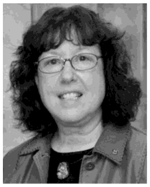 Marjorie Skubic (S’90–M’91–SM’13) received the Ph.D. degree in computer science from Texas A&M University, College Station, TX, USA, in 1997, where she specialized in distributed telerobotics and robot programming by demonstration.
Marjorie Skubic (S’90–M’91–SM’13) received the Ph.D. degree in computer science from Texas A&M University, College Station, TX, USA, in 1997, where she specialized in distributed telerobotics and robot programming by demonstration.
She is currently a Professor in the Electrical and Computer Engineering Department at the University of Missouri, Columbia, with a joint appointment in computer science. In addition to her academic experience, she has spent 14 years working in industry on real-time applications such as data acquisition and automation. Her current research interests include sensory perception, computational intelligence, human–robot interaction, and sensor networks for eldercare. In 2006, she established the Center for Eldercare and Rehabilitation Technology at the University of Missouri and serves as the Center Director for this interdisciplinary team. The focus of the center’s work includes monitoring systems for tracking the physical and cognitive health of elderly residents in their homes, logging sensor data, developing visualizations and clinical decision support systems, extracting activity and gait patterns, identifying changes in patterns, correlating sensor data patterns to health changes, and generating alerts for health changes.
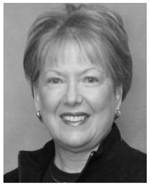 Marilyn Rantz (M’12) received the Ph.D. degree in nursing from the University of Wisconsin, Milwau-kee, USA, in 1992, where she specialized in long-term care health policy and public program evaluation and gerontological nursing.
Marilyn Rantz (M’12) received the Ph.D. degree in nursing from the University of Wisconsin, Milwau-kee, USA, in 1992, where she specialized in long-term care health policy and public program evaluation and gerontological nursing.
She is currently a Curators Professor at the Sinclair School of Nursing, University of Missouri, Columbia, where additionally she holds the named position of University Hospital Professor of Nursing, has an appointment as Professor in the Department of Family and Community Medicine in the MU School of Medicine.
Dr. Rantz developed and sustained a research program to improve quality of care of elderly. Her innovative work in nursing home quality spans nearly 30 years, in practice and as a leading researcher, and establishes her as a premier international expert in quality measurement in nursing homes. In late 2012, election to the Institute and Medicine and also secured a $14.8 million grant from the Centers for Medicare and Medicaid Services for their Initiative to Reduce Avoidable Hospitalizations among Nursing Facility Residents; the largest ever received across the entire University of Missouri, Columbia campus. In total, she and her multidisciplinary research teams have garnered nearly $60 million in funds to support their work measuring effectiveness of nurse care coordination, conduct cutting edge research in long-term care, new delivery models of care, and for technology development to enhance aging in place of community-dwelling elders. She is a fellow of the American Academy of Nursing.
Paul E. Cuddihy, photograph and biography not available at the time of publication.
Footnotes
Color versions of one or more of the figures in this paper are available online at http://ieeexplore.ieee.org.
Contributor Information
Fang Wang, Email: fwnf5@mail.missouri.edu, Department of Computer Science, University of Missouri, Columbia, MO 65211 USA.
Marjorie Skubic, Email: skubicm @missouri.edu, Department of Electrical and Computer Engineering, University of Missouri, Columbia, MO 65211 USA.
Marilyn Rantz, Email: rantzm@missouri.edu, Sinclair School of Nursing, University of Missouri, Columbia, MO 65211 USA.
Paul E. Cuddihy, Email: cuddihy@ge.com, General Electric Global Research, Niskayuna, NY 12309 USA
References
- 1.Marek KD, Popejoy L, Petroski G, Mehr D, Rantz M, Lin WW. Clinical outcomes of aging in place. Nursing Res. 2005;54(3):202–211. doi: 10.1097/00006199-200505000-00008. [DOI] [PubMed] [Google Scholar]
- 2.Hausdorff JM, Rios DA, Edelber HK. Gait variability and fall risk in community–living older adults: A 1–year prospective study. Archives Phys Med Rehabil. 2001;82(8):1050–1056. doi: 10.1053/apmr.2001.24893. [DOI] [PubMed] [Google Scholar]
- 3.Hornbrook MC, Stevens VJ, Wingfield DJ, Hollis JF, Greenlick MR, Ory MG. Preventing falls among community–dwelling older persons: Results from a randomized trial. Gerontologist. 1994;34(1):16–23. doi: 10.1093/geront/34.1.16. [DOI] [PubMed] [Google Scholar]
- 4.Stevens JA. Fatalities and injuries from falls among older adults—United States, 1993–2003 and 2001–2005. Morb Mortal Wkly Rep. 2006;55(45):1221–1224. [PubMed] [Google Scholar]
- 5.Barak Y, Wagenaar RC, Holt KG. Gait characteristics of elderly people with a history of falls: A dynamic approach. Phys Therapy. 2006;86(11):1501–1510. doi: 10.2522/ptj.20050387. [DOI] [PubMed] [Google Scholar]
- 6.Wang F, Stone E, Skubic M, Keller J, Abbott C, Rantz M. Towards a passive low-cost in-home gait assessment system for older adults. IEEE J Biomed Health Informat. 2013 Mar;17(2):346–355. doi: 10.1109/JBHI.2012.2233745. [DOI] [PMC free article] [PubMed] [Google Scholar]
- 7.Wang S, Skubic M, Zhu Y. Activity density map visualization and dissimilarity comparison for eldercare monitoring. IEEE Trans Inf Technol Biomed. 2012 Jul;16(4):607–614. doi: 10.1109/TITB.2012.2196439. [DOI] [PubMed] [Google Scholar]
- 8.Wang F, Stone E, Dai W, Banerjee T, Giger J, Krampe R, Rantz M, Skubic M. Testing an in-home gait assessment tool for older adults. Proc IEEE Eng Med Biol Soc Conf. 2009:6147–6150. doi: 10.1109/IEMBS.2009.5333897. [DOI] [PubMed] [Google Scholar]
- 9.Demiris G, Rantz MJ, Aud MA, Martek KD, Tyrer HW, Skubic M, Hussam AA. Older adults attitudes towards and perceptions of ‘smart home’ technologies: A pilot study. Med Informat. 2004;29:87–84. doi: 10.1080/14639230410001684387. [DOI] [PubMed] [Google Scholar]
- 10.Hagler S, Austin D, Hayes TL, Kaye J, Pavel M. Unobtrusive and ubiquitous in-home monitoring: A methodology for continuous assessment of gait velocity in elders. IEEE Trans Biomed Eng. 2010 Apr;57(4):813–820. doi: 10.1109/TBME.2009.2036732. [DOI] [PMC free article] [PubMed] [Google Scholar]
- 11.Rubenstein LZ. Falls in older people: Epidemiology, risk factors and strategies for prevention. Age Aging. 2006;35–S2:ii37–ii47. doi: 10.1093/ageing/afl084. [DOI] [PubMed] [Google Scholar]
- 12.Li C, Cummings J, Lam J, Graves E, Wu W. Radar remote monitoring of vital signs. IEEE Microw Mag. 2009 Feb;10(1):47–56. [Google Scholar]
- 13.Lazaro A, Girbau D, Villarino R. Analysis of vital signs monitoring using an IR-UWB radar. Progress Electromagn Res. 2010;100:265–284. [Google Scholar]
- 14.Geisheimer JL, Marshall WS, Greneker E. A continuous-wave (CW) radar for gait analysis. Proc. Conf. Rec. 35th Asilomar Conf. Signals, Syst. Comput; 2001. pp. 834–838. [Google Scholar]
- 15.Tahmoush D, Silvious J. Stride rate in radar micro-doppler images. Proc. IEEE Int. Conf. Syst., Man Cybern; 2009. pp. 4323–4328. [Google Scholar]
- 16.Otero M. Application of a continuous wave radar for human gait recognition. Proc. IEEE Int. Conf. Syst., Man Cybern; 2009. pp. 4323–4328. [Google Scholar]
- 17.Tivive F, Bouzerdoum A, Amin MG. A human gait classification method based on radar doppler spectrograms. EURASIP J Advances Signal Process. 2010;2010:Article ID 389716. [Google Scholar]
- 18.Orović I, Stankovic S, Amin M. A new approach for classification of human gait based on time-frequency feature representations. J Signal Process. 2011;91(6):1448–1456. [Google Scholar]
- 19.Kim Y, Ling H. Human activity classification based on micro-doppler signatures using a support vector machine. IEEE Trans Geosci Remote Sens. 2009 May;47(5):1328–1337. [Google Scholar]
- 20.[Online]. Available: www.interlogix.com/_/assets/library/1036806B_RCR50_inin.pdf
- 21.Mehmood A, Sabatier JM, Bradley M, Ekimov A. Extraction of the velocity of walking human’s body segments using ultrasonic doppler. J Acoust Soc Am. 2010;128(5) doi: 10.1121/1.3501115. [DOI] [PubMed] [Google Scholar]
- 22.Yardibi T, Cuddihy P, Genc S, Bufi C, Skubic M, Rantz M, Liu L, Phillips C. Gait characterization via pulse-doppler radar. Proc IEEE Intl Conf Pervasive Comput Communic: Workshop Smart Environ Enhance Health. 2011:662–667. [Google Scholar]
- 23.Phillips CE, III, Keller J, Popescu M, Skubic M, Rantz MJ, Cuddihy PE, Yardibi T. Radar walk detection in the apartments of elderly to assist with assessing fall risk. Proc IEEE Eng Med Biol Soc Conf. 2012:5863–5866. doi: 10.1109/EMBC.2012.6347327. [DOI] [PubMed] [Google Scholar]
- 24.Cuddihy PE, Yardibi T, Legenzoff ZJ, Liu L, Philips E, Abott C, Galambos C, Keller J, Popescu M, Back J. Radar walking speed measurements of seniors in their apartments: Technology for fall prevention. Proc IEEE Eng Med Biol Soc Conf. 2012:260–263. doi: 10.1109/EMBC.2012.6345919. [DOI] [PubMed] [Google Scholar]
- 25.[Online]. Available: www.dataq.com
- 26.Stone EE, Skubic M. Silhouette classification using pixel and voxel features for improved elder monitoring in dynamic environments. Proc. IEEE Pervasive Comput. Commun. Workshops; 2011. pp. 655–661. [Google Scholar]




